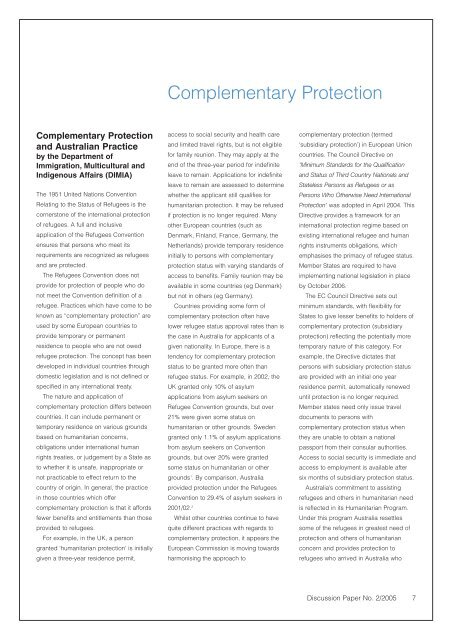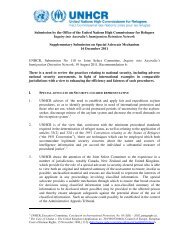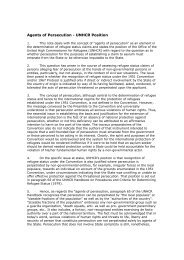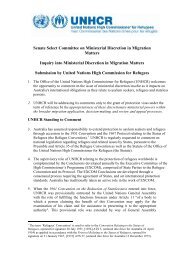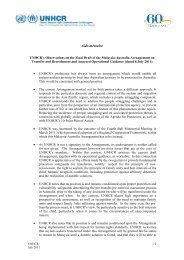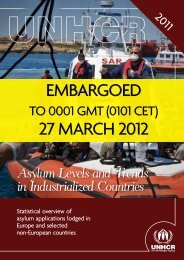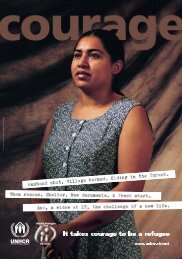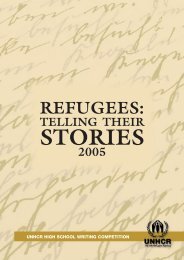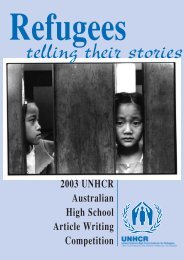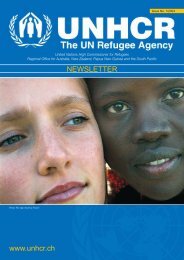Asylum seekers in the waiting room of the UNHCR refugee reception center in Moscow, 2004.Photo: UNHCR/V. Sokolovapermanent residence and the rights whichthat entails. Persons ‘in need of protection’encompass people falling outside the<strong>Refugee</strong> Convention who face a personaldanger of being tortured (as defined inarticle 1 of the Convention against Torture),as well as those who face a personal risk tolife or a risk of cruel and unusual treatmentor punishment where:(i) the person is unable or, because of thatrisk, unwilling to avail themself of theprotection of that country,(ii) the risk would be faced by the personin every part of that country and is notfaced generally by other individuals inor from that country,(iii) the risk is not inherent or incidental tolawful sanctions, unless imposed indisregard of accepted internationalstandards, and(iv) the risk is not caused by the inability ofthat country to provide adequate healthor medical care. 5Regulations may prescribe furtherclasses of such persons.In addition to these ‘front-end’ protectioncategories, anyone who has been issuedwith a removal order in Canada may applyfor Pre-Removal Risk Assessment (PRRA).This procedure acts as a safeguard forpeople facing imminent deportation,although unsuccessful asylum seekers mayonly apply for it where new information hascome to light since the asylum decision wasmade. PRRA assesses the same groundsfor protection as the ‘protected person’claim (risk of persecution, danger of torture,risk to life or risk of cruel and unusualtreatment or punishment), and may lead topermanent residency for persons identifiedas having protection needs.In the US, people may also apply forprotection on the basis of torture. Ifapplicants can show that they are ‘morelikely than not’ to be tortured if removed to aparticular country, then protection based onthe Convention against Torture (CAT) willissue.There are two types of protection withinthe CAT protection framework: ‘withholdingof removal’ and ‘deferral of removal’.‘Withholding of removal’ is the moregenerous form of CAT protection, as itaccords beneficiaries some of the samebenefits as Convention refugees, but notfamily reunification or access to a specialprocess to adjust to permanent residence.Once granted, the onus is on theDepartment of Homeland Security to showthat return is safe.Deferral of removal is a more transientform of relief. It is granted to persons whoare more likely than not to be tortured ifremoved, but who are ineligible forwithholding of removal. It does not confer alawful or permanent immigration status 6 ornecessarily require that an applicant bereleased from detention or prison if held insuch a facility. 7 Furthermore, the grant issubject to review and can be withdrawnquickly and easily once the risk of torturehas diminished. 8 It effectively amounts tonothing more than a ‘tolerated’ status.By comparison to Australia, theprotection regimes in the EU, Canada andthe US appear generous and expansive.Nevertheless, there remain significantprotection ‘gaps’ in national versions ofcomplementary protection – in particular,the question of status for persons excludedfrom protection but who cannot be removeddue to prohibitions on refoulement underinternational law. Furthermore, the quality ofthe domestic status granted to beneficiariesof complementary protection variesconsiderably. For example, Canada grantsan identical status to Convention refugeesand other persons in need of protection,whereas the EU accords beneficiaries ofsubsidiary protection a secondary status –a decision reflecting political motivations butwhich is not justified by international law.Similarly, beneficiaries of subsidiaryprotection are given shorter residencepermits than Convention refugees, despitethe lack of empirical evidence to supportsubsidiary protection as a temporary status.Nevertheless, though the EU Directive ishallmarked by political compromise, itimportantly recognizes States’ broader nonrefoulementobligations under internationallaw and allows individuals to claimprotection on those bases. In spite of itsdrawbacks, it is still preferable to Australia’snarrow protection regime.In any case, the shortcomings of nationalcomplementary protection systems, relativeto the widened categories of personsprotected by them, are an inadequateexcuse to delay the implementation ofcomplementary protection in Australia.Ultimately, it is the standards andobligations contained in international law,both in relation to eligibility for protectionand substantive rights, that provide thecrucial legal foundations for any domesticcomplementary protection regime.*(BA (Hons) LLB (Hons) (Syd) DPhil (Oxon); Lecturer,Faculty of Law, University of Sydney. Email:janem@law.usyd.edu.au.1. Council Directive 2004/83/EC of 29 April 2004 onMinimum Standards for the Qualification and Status ofThird Country Nationals or Stateless Persons as<strong>Refugee</strong>s or as Persons Who Otherwise NeedInternational Protection and the Content of the ProtectionGranted [2004] OJ L304/12.2. Opinion of the Economic and Social Committee on the‘Proposal for a Council Directive on Minimum Standardsfor the Qualification and Status of Third-CountryNationals and Stateless Persons as <strong>Refugee</strong>s or asPersons Who Otherwise Need International Protection’(COM(2001) 510 final- 2001/0207 (CNS)) (2002/C221/11) OJ C221/43 (17 September 2002) (Brussels 29May 2002) [1.9].3. The Directive does not apply to Denmark, inaccordance with articles 1 and 2 of the Protocol on thePosition of Denmark annexed to the Treaty on EuropeanUnion [2002] OJ C325/5 and the Treaty establishing theEuropean Community [2002] OJ C325/33: Directiverecital 40.4. 7944/04 ASILE 21 (31 March 2004) art 2(e). It wasoriginally art 5, but was moved to the definitions sectionin art 2 by 11356/02 ASILE 40 (6 September 2002).5. Immigration and <strong>Refugee</strong> Protection Act 2001 s 97(1).6. CFR §208.17(b)(i) (2000).7. CFR §208.17(b)(ii) (2000).8. CFR §208.17(b)(iii) (2000).6 Discussion Paper No. 2/2005
Complementary ProtectionComplementary Protectionand Australian Practiceby the Department ofImmigration, Multicultural andIndigenous Affairs (DIMIA)The 1951 United Nations ConventionRelating to the Status of <strong>Refugee</strong>s is thecornerstone of the international protectionof refugees. A full and inclusiveapplication of the <strong>Refugee</strong>s Conventionensures that persons who meet itsrequirements are recognized as refugeesand are protected.The <strong>Refugee</strong>s Convention does notprovide for protection of people who donot meet the Convention definition of arefugee. Practices which have come to beknown as “complementary protection” areused by some European countries toprovide temporary or permanentresidence to people who are not owedrefugee protection. The concept has beendeveloped in individual countries throughdomestic legislation and is not defined orspecified in any international treaty.The nature and application ofcomplementary protection differs betweencountries. It can include permanent ortemporary residence on various groundsbased on humanitarian concerns,obligations under international humanrights treaties, or judgement by a State asto whether it is unsafe, inappropriate ornot practicable to effect return to thecountry of origin. In general, the practicein those countries which offercomplementary protection is that it affordsfewer benefits and entitlements than thoseprovided to refugees.For example, in the UK, a persongranted ‘humanitarian protection’ is initiallygiven a three-year residence permit,access to social security and health careand limited travel rights, but is not eligiblefor family reunion. They may apply at theend of the three-year period for indefiniteleave to remain. Applications for indefiniteleave to remain are assessed to determinewhether the applicant still qualifies forhumanitarian protection. It may be refusedif protection is no longer required. Manyother European countries (such asDenmark, Finland, France, Germany, theNetherlands) provide temporary residenceinitially to persons with complementaryprotection status with varying standards ofaccess to benefits. Family reunion may beavailable in some countries (eg Denmark)but not in others (eg Germany).Countries providing some form ofcomplementary protection often havelower refugee status approval rates than isthe case in Australia for applicants of agiven nationality. In Europe, there is atendency for complementary protectionstatus to be granted more often thanrefugee status. For example, in 2002, theUK granted only 10% of asylumapplications from asylum seekers on<strong>Refugee</strong> Convention grounds, but over21% were given some status onhumanitarian or other grounds. Swedengranted only 1.1% of asylum applicationsfrom asylum seekers on Conventiongrounds, but over 20% were grantedsome status on humanitarian or othergrounds 1 . By comparison, Australiaprovided protection under the <strong>Refugee</strong>sConvention to 29.4% of asylum seekers in2001/02. 2Whilst other countries continue to havequite different practices with regards tocomplementary protection, it appears theEuropean Commission is moving towardsharmonising the approach tocomplementary protection (termed‘subsidiary protection’) in European Unioncountries. The Council Directive on‘Minimum Standards for the Qualificationand Status of Third Country Nationals andStateless Persons as <strong>Refugee</strong>s or asPersons Who Otherwise Need InternationalProtection’ was adopted in April 2004. ThisDirective provides a framework for aninternational protection regime based onexisting international refugee and humanrights instruments obligations, whichemphasises the primacy of refugee status.Member States are required to haveimplementing national legislation in placeby October 2006.The EC Council Directive sets outminimum standards, with flexibility forStates to give lesser benefits to holders ofcomplementary protection (subsidiaryprotection) reflecting the potentially moretemporary nature of this category. Forexample, the Directive dictates thatpersons with subsidiary protection statusare provided with an initial one yearresidence permit, automatically reneweduntil protection is no longer required.Member states need only issue traveldocuments to persons withcomplementary protection status whenthey are unable to obtain a nationalpassport from their consular authorities.Access to social security is immediate andaccess to employment is available aftersix months of subsidiary protection status.Australia’s commitment to assistingrefugees and others in humanitarian needis reflected in its Humanitarian Program.Under this program Australia resettlessome of the refugees in greatest need ofprotection and others of humanitarianconcern and provides protection torefugees who arrived in Australia whoDiscussion Paper No. 2/20057


